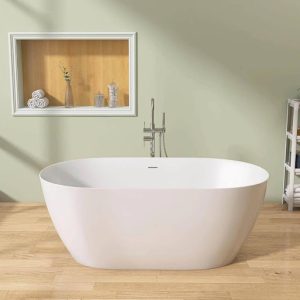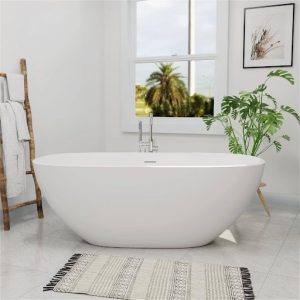White bathtubs have long been a go-to for creating a clean, bright bathroom aesthetic. Their crisp tone blends seamlessly with any decor style—minimalist, vintage, or spa-inspired. But one common concern lingers in the minds of many homeowners: Do white bathtubs show dirt more easily?
The answer isn’t black and white (pun intended). In fact, how “dirty” a white bathtub appears often has more to do with its material than the color itself. Let’s unpack the truth about stain resistance and surface maintenance across different tub materials.
- The “Dirty” Illusion: When Color and Surface Texture Play Tricks on You
Visually, white is the most “honest” color. Every water spot, soap scum mark, or stray hair is immediately noticeable on a white surface. In contrast, darker bathtubs can better conceal these everyday messes, making them appear cleaner even when they’re not.
But don’t confuse “shows dirt” with “gets dirty”. The actual ability of a bathtub to resist staining or buildup depends more on its material and surface smoothness. A glossy, smooth white tub may simply allow grime to sit on the surface—easy to wipe away—whereas a rougher dark surface can trap dirt in micro-textures and be harder to clean thoroughly.
- Acrylic & Fiberglass Tubs: Yellowing Is the Real Enemy

Acrylic and fiberglass tubs are lightweight and budget-friendly, making them a popular choice for many households. However, their biggest long-term issue isn’t dirt—it’s oxidation and yellowing.
Acrylic bathtubs are coated with a resin layer that gives them a glossy, easy-to-clean finish. But over time, exposure to hot water, soaps, shampoos, and even sunlight can cause the resin to break down, turning the surface from white to dull yellow. Hard water can make things worse—calcium and magnesium deposits build up, forming hard-to-remove limescale that dulls the finish and speeds up aging.
Fiberglass tubs, made from reinforced plastic with a resin overlay, face similar issues. After a few years, even with frequent cleaning, discoloration becomes tough to reverse, leaving the tub looking worn and grimy.
To slow this process, avoid harsh cleaners (like bleach or strong acids) and opt for gentle, pH-neutral products. Dry the tub after each use and regularly treat it with an acrylic-safe cleaner. Still, even with diligent care, yellowing over time is often inevitable due to the nature of the materials.
Further Reading: How to Make Your Bathtub White Again
- Solid Surface Tubs: Stain-Resistant and Refreshable

If you love white but want durability, solid surface tubs (like cultured stone or resin-based composites) are a fantastic upgrade. These tubs feature a non-porous, seamless surface that naturally resists stains, mildew, and soap buildup.
Even better? They’re refinishable. If your tub starts to show signs of wear—minor yellowing or small scratches—you can sand and polish the surface to restore its original glow. The process typically involves starting with 400-grit sandpaper and working up to 1200-grit for a smooth finish, followed by a surface conditioner to bring back the sheen.
This renewability makes solid surface tubs an excellent long-term investment. If you’re not comfortable refinishing it yourself, many manufacturers offer professional services or warranties to help maintain its look.
Final Thoughts:
So, are white bathtubs harder to keep clean? Not necessarily. What truly matters is the material—not just the color.
Acrylic and fiberglass tubs might discolor or yellow over time, demanding more frequent cleaning. In contrast, solid surface tubs offer superior stain resistance and can be easily refreshed with occasional refinishing.
If you’re captivated by the timeless charm of a white bathtub, don’t let cleaning concerns hold you back. With the right material and a few smart habits—like rinsing and wiping down after use—your tub can stay sparkling clean for years.
Love the look of white? Go for it. The elegance is worth it, and the upkeep doesn’t have to be a dealbreaker.


